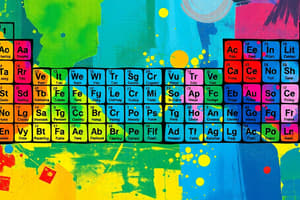Podcast
Questions and Answers
What is the main purpose of the Periodic Table?
What is the main purpose of the Periodic Table?
- To display the colors of different elements
- To organize chemical compounds
- To show the melting points of elements
- To arrange chemical elements based on their atomic number (correct)
How are the elements arranged in the Periodic Table?
How are the elements arranged in the Periodic Table?
- By their atomic number (correct)
- In alphabetical order
- By their density
- Based on their molecular weight
What do the rows in the Periodic Table represent?
What do the rows in the Periodic Table represent?
- The number of protons in an atom
- The atomic weight of an element
- The number of electron shells in an atom (correct)
- The number of neutrons in an atom
Why are elements in the same group on the Periodic Table said to have similar chemical properties?
Why are elements in the same group on the Periodic Table said to have similar chemical properties?
What was Dmitri Mendeleev's contribution to the development of the Periodic Table?
What was Dmitri Mendeleev's contribution to the development of the Periodic Table?
What is the main purpose of periodic classification in chemistry?
What is the main purpose of periodic classification in chemistry?
Which criteria are NOT used in the classification of elements on the periodic table?
Which criteria are NOT used in the classification of elements on the periodic table?
Why do chemists use the periodic table to help create new compounds?
Why do chemists use the periodic table to help create new compounds?
Which statement best describes the limitations of periodic classification?
Which statement best describes the limitations of periodic classification?
How does periodic classification help chemists in analytical chemistry?
How does periodic classification help chemists in analytical chemistry?
Study Notes
Periodic Classification and the Periodic Table: A Primer
Imagine walking into a candy store filled with thousands of different types of sweets, all arranged in a logical and systematic manner. The Periodic Table is like that candy store, but instead of delightful treats, it organizes the fundamental building blocks of the universe—chemical elements.
The Periodic Table
The Periodic Table is a visual representation of chemical elements, described by their atomic number, symbol, and common name. The table is divided into rows (periods) and columns (groups). This organization allows chemists to easily compare and predict the properties of elements based on their positions.
Development of the Periodic Table
The idea for a periodic table dates back to the 18th century, but it wasn't until the mid-19th century that Dmitri Mendeleev, a Russian chemist, developed the modern Periodic Table in 1869. Mendeleev's major contribution was to arrange elements based on their atomic weights, recurring patterns, and gap-filling strategy.
Periods and Groups
The rows in the Periodic Table, called periods, represent the number of electron shells in an atom (from one to seven). The columns, or groups, are categorized by the number of valence electrons (the electrons in the outermost shell) and share similar chemical properties.
- Groups 1 (Alkali metals) and 2 (Alkaline earth metals) contain elements with one and two valence electrons, respectively. They are highly reactive, forming positive ions and compounds with non-metals.
- Groups 13-18 (Aluminum group to Noble gases) are known as the transition metals, post-transition metals, and noble gases. These elements exhibit a variety of chemical and physical properties.
Periodic Classification
Periodic classification is the process by which chemists group elements based on their periodic table position, atomic properties, and chemical behavior. This system allows for a systematic approach to understanding and predicting elemental behavior.
Classification Criteria
- Atomic number: The number of protons in an atom's nucleus.
- Electronic configuration: Arrangement of electrons in an atom's shells.
- Period: Number of electron shells.
- Group: Number of valence electrons and similar chemical properties.
Applications and Advantages of Periodic Classification
- Predicting element properties: By understanding an element's group and period, we can predict its chemical behavior.
- Building compounds: Periodic classification helps chemists create new compounds with desired properties.
- Analytical chemistry: Periodic tables simplify the identification of elements in various samples.
- Understanding trends: Periodic classification reveals trends in atomic size, ionization energy, electron affinity, and electronegativity as elements progress across periods and down groups.
Limitations of Periodic Classification
- The Periodic Table does not account for the complex behavior of some elements, such as the Periodic Table's lack of a separate column for lanthanides and actinides.
- The presentation of the table ignores the complexities of some elements' electronic structures, such as the occurrence of multiple electron configurations.
In summary, the Periodic Table and periodic classification are essential tools for understanding the fundamental building blocks of the universe and their behavior. With periodic classification, chemists can predict the properties and reactivity of elements, identify new compounds, and simplify the analysis of complex samples—just like a candy store map helps you find your favorite treats!
Studying That Suits You
Use AI to generate personalized quizzes and flashcards to suit your learning preferences.
Description
Test your knowledge of the Periodic Table and its classification system with this quiz. Explore the development of the Periodic Table, understand the significance of periods and groups, and learn about the criteria used for classifying elements. Discover the applications, advantages, and limitations of periodic classification in chemistry.




